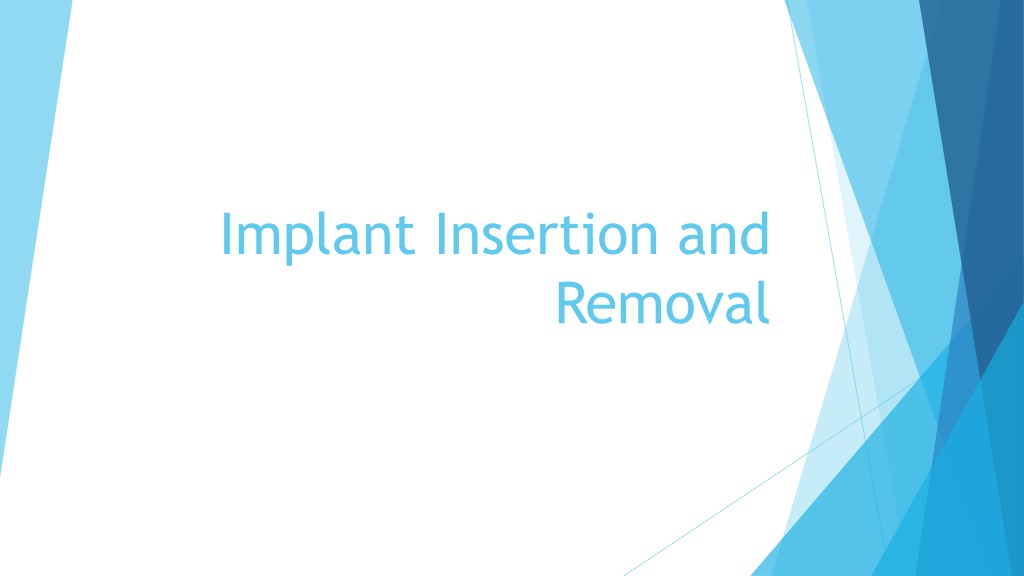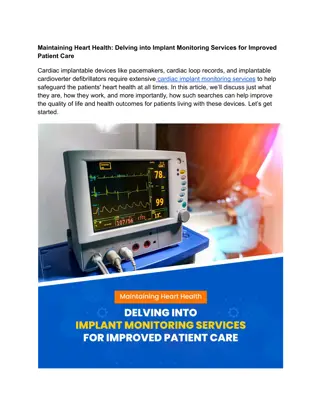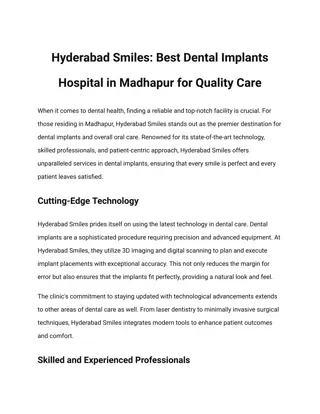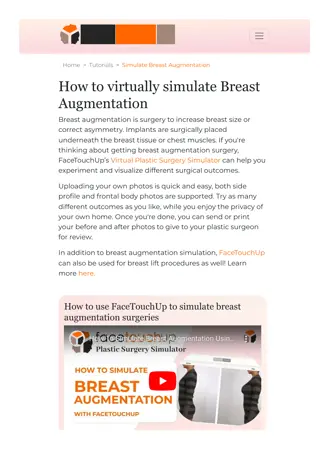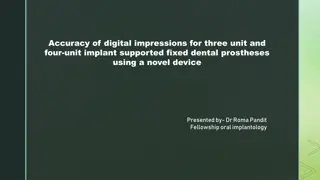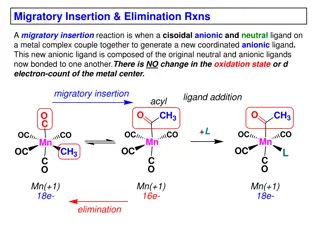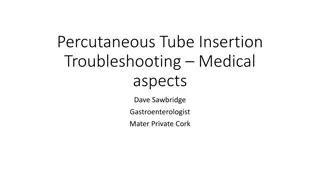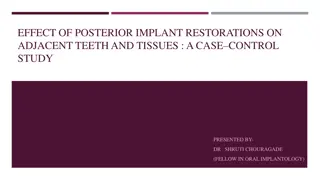Guide to Implant Insertion and Removal
Essential steps and equipment required for the insertion of implants, including patient positioning, skin preparation, insertion techniques, and post-insertion care. Detailed instructions on how to handle potential complications during the insertion process and necessary follow-up steps for successful implant procedures.
Download Presentation

Please find below an Image/Link to download the presentation.
The content on the website is provided AS IS for your information and personal use only. It may not be sold, licensed, or shared on other websites without obtaining consent from the author. Download presentation by click this link. If you encounter any issues during the download, it is possible that the publisher has removed the file from their server.
E N D
Presentation Transcript
Implant Insertion and Removal
Materials for Insertion The following equipment is needed for insertion: Sterile surgical drapes Sterile gloves Antiseptic solution Surgical marker Local anesthetic Needles and syringe Sterile gauze Adhesive bandage Pressure bandage
Patient Insertion Position View applicator from the side and not from above the arm. Non-dominant arm flexed, hand underneath head. This position deflects ulnar nerve away from insertion site.
Insertion Step 1. Position and mark
Insertion Step 2. Clean and anesthetize (with epi recommended) Step 3. Open blister pack and remove cap - should see implant by looking into tip of needle (DO NOT touch slider) Step 4. Stretch skin toward elbow If the purple slider is released prematurely, restart the procedure with a new applicator
Insertion Step 5. Viewing from the side puncture the skin bevel in only Step 6. Lower the applicator, lift the skin, slide needle in fully Readjust as needed Insert bevel on an angle Lower angle & lift skin Slide in all the way
Insertion Step 7. Without moving applicator, move the slider fully back until it stops. Step 8. Bandage, verify position and have pt. palpate Step 9. Apply small bandage then pressure bandage over it
Insertion If applicator is moved during insertion or if purple slider is not moved fully back, implant may protrude from insertion site If implant is protruding, remove and perform new procedure at same insertion site using a new applicator Do not push protruding implant back into incision
Post-insertion Steps May remove: Pressure bandage in 24 hours Small adhesive bandage over insertion site after 3 to 5 days Complete Patient Alert Card and give to woman to keep Complete adhesive label and affix to woman s medical record (and/or record batch number if electronic medical record)
If Implant is Not Palpable After Insertion May not have been inserted or inserted too deeply: Check applicator: Needle should be fully retracted and only purple tip of the obturator should be visible Use other methods to confirm the presence of implant. X-ray, CT scan, Ultrasound, MRI
Radiopaque Implant X-ray Localization Mansour D et al. Contraception 2010;82:243 9. Adapted with permission.
If Imaging Methods Fail to Locate the Implant Until presence of implant verified non-hormonal contraceptive method must be used Deeply-placed implants removed ASAP to avoid distant migration Serum etonogestrel assay can be requested to confirm presence of etonogestrel subdermal implant Contact Merck Canada for further guidance
Most Frequent Clinician-reported Events at Insertion (N=7364) Real-world Evidence: Nexplanon Observational Risk Assessment (NORA) Study Insertion event Incorrect insertion Deep insertion Partial insertion Non-insertion Insertion-related challenge Difficulty removing protection cap Difficulty sliding needle to full length in skin Difficulty handling the device/visualization Number* 93 65 27 1 % incidence 1.3 0.9 0.4 0.01 95% CI 1.0 1.6 0.7 1.1 0.2 0.5 0.0 0.08 93 1.3 1.0 1.5 30 0.4 0.3 0.6 17 0.2 0.1 0.4 13 * *Number of insertions; 26 (60%) were reported by a single clinician CI, confidence interval Reed S et al. Contraception 2019;100:31-6.
Removal The following equipment is needed for the implant removal: Sterile surgical drapes Sterile gloves Antiseptic solution Surgical marker Local anesthetic Needles and syringe Sterile scalpel Forceps (straight and curved mosquito) Sterile adhesive wound closure Sterile gauze Pressure bandage
Removal Step 1. Locate the implant and push down, mark the distal end Step 2. Clean, anesthetize (inject under implant!) Step 3. Push down, make parallel incision
Removal Step 4. Implant should pop through incision, grasp the implant with forceps, remove and confirm length Step 5. Dissect if needed Step 6. Insert new Nexplanon in same incision prn Step 7. Sterile adhesive wound closure and pressure bandage
After Removing the Implant Remove: Pressure bandage after 24 hours Sterile adhesive wound closure after 3 to 5 days Restart contraception immediately
Possible Factors Complicating Removal Implant not inserted correctly Implant inserted too deeply Implant encased in fibrous tissue Implant not palpable Implant has migrated
Removal of a Non-Palpable Implant Localization and removal of non-palpable implants is recommended ASAP Exploratory surgery is strongly discouraged Once localized, implant should be removed by HCP experienced in removing deeply placed implants, consider ultrasound guidance If not found consider radiographic examination of chest
Insertion Video Link to: http://www.nexplanonvideos.com/home_lander_subs.html?country=EN|Nexplan on
